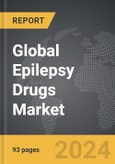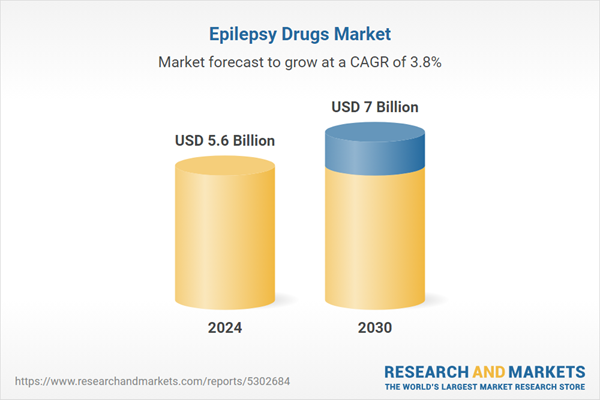Global Epilepsy Drugs Market - Key Trends & Drivers Summarized
Why Are Epilepsy Drugs Vital for Patient Quality of Life and Seizure Management?
Epilepsy drugs, or antiepileptic drugs (AEDs), are essential for managing seizures in people with epilepsy, a neurological disorder characterized by recurrent, unprovoked seizures due to abnormal brain activity. AEDs help reduce the frequency, duration, and intensity of seizures, providing patients with better control over their condition, improving their quality of life, and minimizing the risk of injury or complications. With various epilepsy types, including focal, generalized, and mixed seizures, treatment often requires tailored drug therapies to meet individual patient needs. AEDs range from older generation drugs like phenytoin and carbamazepine to newer medications such as levetiracetam, lamotrigine, and brivaracetam, which often have improved efficacy, fewer side effects, and better safety profiles.Managing epilepsy effectively with drugs is critical, as uncontrolled seizures can lead to physical injuries, cognitive impairment, and reduced productivity. Effective AEDs allow many individuals to lead active, fulfilling lives by providing greater freedom from the unpredictable nature of epilepsy. With the growing focus on patient-centric care, epilepsy drugs are continuously evolving to improve efficacy, reduce side effects, and offer individualized treatment options, making them essential for patient well-being and safety.
How Are Technological Advancements Shaping the Epilepsy Drugs Market?
Technological and scientific advancements are driving significant changes in the epilepsy drugs market by improving drug efficacy, safety, and personalization. Innovations in drug formulation and delivery, such as extended-release tablets and oral suspensions, are improving dosing convenience and adherence, which is critical for patients requiring consistent therapeutic levels. Extended-release formulations help maintain stable drug levels, reducing the likelihood of breakthrough seizures and minimizing side effects associated with dosage fluctuations. Oral solutions and suspensions are also providing improved options for children and elderly patients who may have difficulty with traditional tablets.Additionally, advances in pharmacogenomics and precision medicine are enabling more personalized epilepsy treatments. By understanding genetic markers associated with drug metabolism and efficacy, clinicians can tailor AEDs to better suit each patient, minimizing adverse effects and optimizing seizure control. New drug development in novel pathways, including drugs targeting GABA receptors and glutamate modulators, offers potential for those with drug-resistant epilepsy, a population with limited treatment options. Together, these technological advancements are expanding the therapeutic landscape for epilepsy, supporting personalized care and improved patient outcomes.
What Are the Key Types of Epilepsy Drugs?
Epilepsy drugs can be categorized into several types based on their mechanisms of action, each targeting specific pathways to reduce or prevent seizures. The major classes include sodium channel blockers, calcium channel blockers, GABA enhancers, and glutamate inhibitors. Sodium channel blockers, such as phenytoin, carbamazepine, and lamotrigine, work by inhibiting excessive electrical activity in the brain, which is often responsible for seizure activity. Calcium channel blockers, like ethosuximide, help reduce neuronal excitability, making them effective in managing absence seizures.GABA enhancers, such as benzodiazepines and phenobarbital, increase the inhibitory effect of GABA, a neurotransmitter that reduces brain activity, providing a calming effect on neuronal firing. Glutamate inhibitors, including perampanel, act on glutamate, an excitatory neurotransmitter, to prevent excessive stimulation of brain neurons. Novel AEDs, like brivaracetam, target SV2A proteins, providing new therapeutic options for patients with complex or drug-resistant epilepsy. These various drug types enable clinicians to target the specific mechanisms associated with each type of epilepsy, helping to reduce seizure frequency and improve treatment efficacy.
What Is Driving Growth in the Epilepsy Drugs Market?
The growth in the epilepsy drugs market is driven by increasing prevalence of epilepsy, rising awareness of treatment options, advancements in drug formulations, and a growing demand for novel therapies for drug-resistant epilepsy. Epilepsy is one of the most common neurological disorders worldwide, affecting millions of people of all ages, with a rising incidence in older populations and among individuals with underlying neurological conditions. As awareness of epilepsy grows, more patients seek diagnosis and treatment, increasing demand for effective drug therapies to manage seizures.Technological advancements in drug formulations and personalized medicine are also supporting market growth by making treatment more accessible and effective. Extended-release formulations, for example, improve patient adherence, especially in individuals who struggle with multiple daily doses. In addition, the focus on drug-resistant epilepsy has led to substantial research and development investments in new drug classes, providing potential alternatives for those who do not respond to traditional AEDs. Supportive government initiatives, increasing healthcare spending, and improvements in diagnostic technology are further driving demand, making AEDs more accessible in emerging markets.
Together, these factors - the prevalence of epilepsy, advancements in drug technology, the demand for personalized and effective therapies, and government support - are driving substantial growth in the epilepsy drugs market. This growth reflects the critical need for effective AEDs and the importance of ongoing research to enhance the safety, efficacy, and accessibility of treatments for epilepsy patients worldwide.
Report Scope
The report analyzes the Epilepsy Drugs market, presented in terms of market value (US$ Thousand). The analysis covers the key segments and geographic regions outlined below.- Segments: Drug (First Generation, Second Generation, Third Generation); Spectrum Type (Narrow, Broad).
- Geographic Regions/Countries:World; United States; Canada; Japan; China; Europe (France; Germany; Italy; United Kingdom; Spain; Russia; and Rest of Europe); Asia-Pacific (Australia; India; South Korea; and Rest of Asia-Pacific); Latin America (Argentina; Brazil; Mexico; and Rest of Latin America); Middle East (Iran; Israel; Saudi Arabia; United Arab Emirates; and Rest of Middle East); and Africa.
Key Insights:
- Market Growth: Understand the significant growth trajectory of the First Generation Drugs segment, which is expected to reach US$1.6 Billion by 2030 with a CAGR of a 2.9%. The Second Generation Drugs segment is also set to grow at 3.6% CAGR over the analysis period.
- Regional Analysis: Gain insights into the U.S. market, valued at $1.5 Billion in 2024, and China, forecasted to grow at an impressive 5.7% CAGR to reach $1.4 Billion by 2030. Discover growth trends in other key regions, including Japan, Canada, Germany, and the Asia-Pacific.
Why You Should Buy This Report:
- Detailed Market Analysis: Access a thorough analysis of the Global Epilepsy Drugs Market, covering all major geographic regions and market segments.
- Competitive Insights: Get an overview of the competitive landscape, including the market presence of major players across different geographies.
- Future Trends and Drivers: Understand the key trends and drivers shaping the future of the Global Epilepsy Drugs Market.
- Actionable Insights: Benefit from actionable insights that can help you identify new revenue opportunities and make strategic business decisions.
Key Questions Answered:
- How is the Global Epilepsy Drugs Market expected to evolve by 2030?
- What are the main drivers and restraints affecting the market?
- Which market segments will grow the most over the forecast period?
- How will market shares for different regions and segments change by 2030?
- Who are the leading players in the market, and what are their prospects?
Report Features:
- Comprehensive Market Data: Independent analysis of annual sales and market forecasts in US$ Million from 2024 to 2030.
- In-Depth Regional Analysis: Detailed insights into key markets, including the U.S., China, Japan, Canada, Europe, Asia-Pacific, Latin America, Middle East, and Africa.
- Company Profiles: Coverage of players such as Abbott Laboratories, Inc., Cephalon, Inc., GlaxoSmithKline PLC, Johnson & Johnson, Novartis AG and more.
- Complimentary Updates: Receive free report updates for one year to keep you informed of the latest market developments.
Some of the 42 companies featured in this Epilepsy Drugs market report include:
- Abbott Laboratories, Inc.
- Cephalon, Inc.
- GlaxoSmithKline PLC
- Johnson & Johnson
- Novartis AG
- Pfizer, Inc.
- Sanofi Aventis S.A.
- Shire PLC
- Tansna Therapeutics, Inc.
- UCB Pharma, Inc.
This edition integrates the latest global trade and economic shifts into comprehensive market analysis. Key updates include:
- Tariff and Trade Impact: Insights into global tariff negotiations across 180+ countries, with analysis of supply chain turbulence, sourcing disruptions, and geographic realignment. Special focus on 2025 as a pivotal year for trade tensions, including updated perspectives on the Trump-era tariffs.
- Adjusted Forecasts and Analytics: Revised global and regional market forecasts through 2030, incorporating tariff effects, economic uncertainty, and structural changes in globalization. Includes historical analysis from 2015 to 2023.
- Strategic Market Dynamics: Evaluation of revised market prospects, regional outlooks, and key economic indicators such as population and urbanization trends.
- Innovation & Technology Trends: Latest developments in product and process innovation, emerging technologies, and key industry drivers shaping the competitive landscape.
- Competitive Intelligence: Updated global market share estimates for 2025, competitive positioning of major players (Strong/Active/Niche/Trivial), and refined focus on leading global brands and core players.
- Expert Insight & Commentary: Strategic analysis from economists, trade experts, and domain specialists to contextualize market shifts and identify emerging opportunities.
Table of Contents
Companies Mentioned (Partial List)
A selection of companies mentioned in this report includes, but is not limited to:
- Abbott Laboratories, Inc.
- Cephalon, Inc.
- GlaxoSmithKline PLC
- Johnson & Johnson
- Novartis AG
- Pfizer, Inc.
- Sanofi Aventis S.A.
- Shire PLC
- Tansna Therapeutics, Inc.
- UCB Pharma, Inc.
Table Information
| Report Attribute | Details |
|---|---|
| No. of Pages | 276 |
| Published | December 2025 |
| Forecast Period | 2024 - 2030 |
| Estimated Market Value ( USD | $ 5.6 Billion |
| Forecasted Market Value ( USD | $ 7 Billion |
| Compound Annual Growth Rate | 3.8% |
| Regions Covered | Global |









